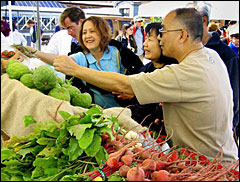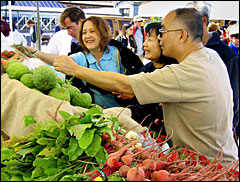When Michelle Obama plunged a shovel into the White House lawn last Friday, she wasn’t just preparing a productive vegetable-garden bed. She’s was also tilling fertile ground for debate about new directions for the food system.
In the New York Times, Andrew Martin helpfully got the ball rolling in a recent piece called “Is a Food Revoution Now in Season?”
I want to focus here on one small part of Martin’s piece, one that I’ve been fixated on since I started to write about food politics a few years ago: the class issue. Specifically, who gets access — who deserves access — to healthy food that’s been grown and processed in ecologically and socially sustainable ways?
(Another key question raised in Martin’s article — what I call the “Can sustainable agriculture feed the world?” conundrum — I’ll address soon. Quick response: Can unsustainable agriculture feed the world — for long?)
In Martin’s article, Nancy Joseph, a professor of food marketing at St. Joseph’s University, addresses the class issue:
… Ms. Childs worries that some of the activists’ recommendations for buying fresh, local or organic food cannot be adopted by many Americans because those foods may be too expensive. “By singling out certain lifestyles and foods, it’s diminishing very good quality nutrition sources,” she says. “Frozen goods, canned goods, they are not bad things. What’s important is that people eat well, within their means.”
“We’d all love to live on a farm in Vermont, right?” she adds.
Childs’ critique can be summed up like this: Fresh, local, and organic food is more expensive than conventional; the U.S. middle class is being squeezed, and there’s a large and growing low-income population; and we’re in the worst economic crisis since the Great Depression.
Therefore, fresh, local, and organic food must be a niche market for the well-off and the food-obsessed (folks willing to make sacrifices in other parts of their lives so they can shop at the farmers market). As one green-products exec tells Martin, “The idea of the true cost of food? … That’s the last thing consumers want to hear right now.”
These are important points. Surely, it’s unedifying to be lectured by someone who lives on a paid-for Vermont farm — or a pristine, rustic house in the Berkeley hills — about the virtues of just-picked produce.
And I think it’s problematic, in a nation wherein real wages have stagnated since the 1970s, to cavalierly demand that people pay more for food.
If we accept our food system as it is, then Childs makes perfect sense. We need an industrialized food system to churn out food that people can afford; the best we can do is nudge the industry to make health and sustainability a bit more of a priority.
From what I can see, the only real way to challenge that logic is to challenge the food system as a whole. Right now, we have an extractive food system — one that extracts wealth from communities and moves it up the commodity chain to corporate shareholders. We need to create a food system that builds wealth within communities — and thus broadens access to fresh, local, and organic food.
What do I mean by extractive? Look at a typical low-income urban neighborhood. In most areas, there’s little space for food production, and people generally buy their food at stores owned by folks outside the neighborhood — fast-food outlets, corner stores, eateries, and (when they exist) large supermarkets.
Here’s a good rule of thumb: even in the lowest-income neighborhoods, people spend about $1000 per head annually on food. In a neighborhood of, say, 10,000 people, food expenditures represent a cool $10 million per year.
Now, where does that money go? In our typical urban neighborhood, it mainly flows to the owners of those fast-food outlets, corner stores, eateries, or large supermarkets — i.e., mainly to distant shareholders.
And what does the community get in return? Well, food — but generally food that appears to be contributing to a host of diet-related maladies such as diabetes and heart disease.
And there’s jobs, but they tend to be low-paid and deskilled. Few industries have seen more relentless pressure on unions than supermarkets since Wal-Mart entered the grocery fray a little more than a decade ago.
As for fast-food jobs, they’re some of the worst work available in the U.S., as Eric Schlosser demonstrated in Fast Food Nation. “While a handful of workers manage to rise up the corporate ladder, the vast majority lack full-time employment, receive no benefits, learn few skills, quit after a few months, and float from job to job,” Schosser wrote. He adds: “The only Americans who consistently earn lower wages are migrant farm workers.”
In other words, as currently structured, the food system is a sieve through which a substantial portion of wealth in low-income communities leaks away — with little of value to show for it.
Yet, that $10 million per year in food expenditures could be deployed in different ways. Imagine productive community gardens spread throughout the neighborhood, that provide fresh vegetables to the folks that tend them, plus a substantial surplus.
Now imagine that surplus is sold a to restaurant owned by community members — one that trains and employs real cooks, not McDonalds-style button-pushers. Some of the profits and wages generated there are spent at a community-owned food coop — one that sources as much produce as possible both from the community gardens and nearby, exurban farmers (since community gardens can’t meet all the needs).
With institutions like these, a large and increasing chunk of that $10 million stays within the community, knocking around, multiplying, and bringing in new forms of industry. Someone realizes that all this local eating is generating food scraps that could be turned into valuable compost for the community gardens — and initiates a work-composting enterprise in the backyard. And so on.
This is the model, I think, that can address the food-and-class problem in the United States. For too long, food has been seen as an input of, not a tool for, economic development. To broaden access to healthy food, that must change.
These ideas aren’t new. Two of my mentors in food-system thinking — Oakland-based Hank Hererra and Minnesota-based Ken Meter — have been making these points forcefully for years. Groups like Milwaukee and Chicago’s Growing Power, Brooklyn’s Added Value, and Oakland’s People’s Grocery have proven they work on the ground.
And you’ll also find them hinted at in such much-revered, little read classics as Jane Jacobs’ Economy of Cities and E.F. Schumaker’s Small is Beautiful.
As the externalized costs of our industrial food system pile up, and the conversation around food policy sparked by Michelle Obama’s veggie garden heats up, I hope these ideas come to the fore.



